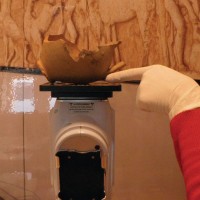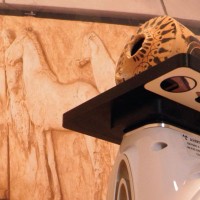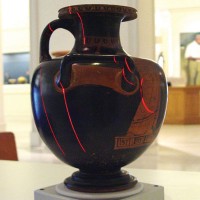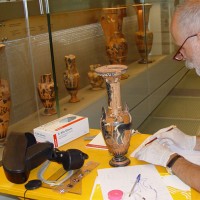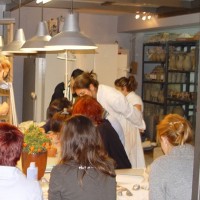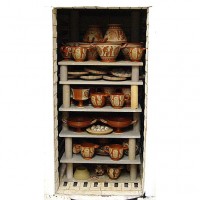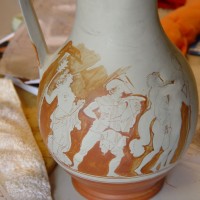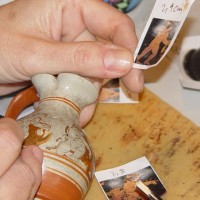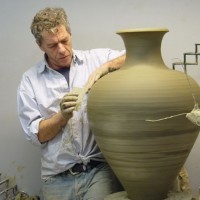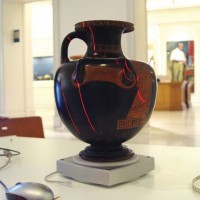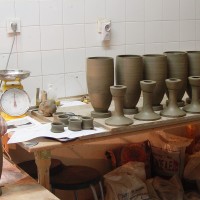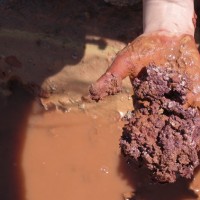THE PROJECT
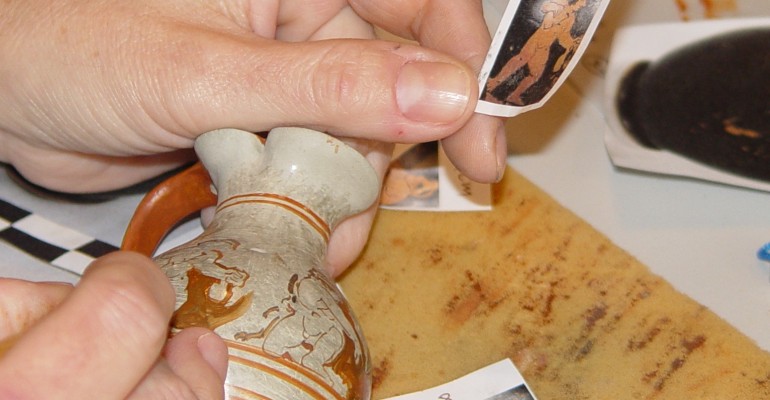
RE3CAP: Research-Recovery-Revival of Classical Attic Pottery
- Design and development of a service to present and highlight the technology of classical Atticceramics aimed initially at visitors of the Kerameikos’ Archaeological Museum.
- Design and development of a service enabling the low cost technologically authentic, museumquality, reproduction of classical Attic pottery through the use of innovative techniques.
Project Goals and Objectives
The major part of scientific research in archaeological ceramics addresses questions relating to thephysicochemical properties of the ceramic body (raw materials used, sizing and mixing of clays,firing temperatures and conditions etc). The motivation for this work has been mainly to answer questions concerning provenance and locality of production. Even though it is the surface decoration that predominantly encodes cultural specificity much less attention has been paid to the physicochemical properties and even less to the technological processes on which it is based. Thereare very few cases where this knowledge has been put to the test by actually reproducing the artefacts.
The lost secrets of Classical Attic Vases
Rise and fall of a technique
Ancient ceramic art and technology reached its apogee in Athenian workshops during the 6th-5thcenturies BC. During this period the artistic and technological quality of the fired black figure, redfigure and plain black glazed vases reached perfection. It was only natural that such perfection hadto be witnessed and established by the application of the creator’s signature of which we haveseveral hundreds of examples. We also witness the emergence of schools and workshops whichapplied signatures as trade marks and guarantees of quality. The incised mark ΝΙΚΟΣΘΕΝΗΣ ΕΠΟΙΗΣΕΝ is the classical precursor of the marks and signatures of the great European workshopsof the last few centuries. The products of Athenian workshops were in great demand throughout theMediterranean markets from Etruria and South Italy, to Carthage, Egypt and the coasts of Anatolia (Asia Minor). The Attic black and red figure vases served as aesthetic and technological referencepoints for the objects of domestic and decorative usage in very much the same way as the productsof the great names of European pottery and glass making (i.e. Wedgwood, Sevres, Limoges,Meissen, Galle, Lalique). The decay of the social and economic fabric of Athens which followedthe Peloponnesian war (431-402 BC) marks the beginning of a long period of gradual deteriorationof both aesthetic and technological standards, the appearance of lower quality imitations and finally during the Roman period the complete abandonment of the technique. This was the end of the “ironreduction technique”, the most widespread process for decorating ceramics which lasted more than 2500 years. Present day copies which are sold in tourist markets are painted over and bear norelation to the techniques of the Classical period.
The rediscovery
The aesthetic interest in Classical antiquity which followed the Renaissance led to an active searchfor the lost technique of the so-called ATTIC BLACK GLAZE (Attic BG). In 1752 le Comte de Caylus published a treatise in France where he describes the glaze as “basically ferruginous earth”. Fifteen years later Josiah Wedgwood, after failing to reproduce the glaze he produced the famous”black basalt” substitutes, decorated in the red-figured style to celebrate the opening of his factoryat Etruria (Staffordshire). During the next two centuries chemists, archaeologists and ceramists metwith the same difficulties to reproduce the Attic BG devoting articles and treatises to the subject.
Schumann (1942), Winter (1959) and Hoffman (1962) in Germany as well as Noble (1966) in the USA attempted to overcome similar difficulties by introducing “exotic” additives such asurine, dregs of wine, blood, bone powder, and wood or seaweed ashes. The definitive answer to the mystery was provided in 1993 by Aloupi3 in Greece in the course of her PhD research on the”Nature and Micromorphology of paint layers in ancient ceramics”. The key to the technique lies in the use of carefully chosen and laboriously processed natural clays in water, followed by a rathercomplex firing cycle during which the clay based paints acquire their final black or red colour depending on the kiln temperature and atmosphere. The result is a ceramic object whose colour, texture, chemical composition and microstructure are indistinguishable from the original. Traditionally, surface decoration has been the domain of the Archaeologist or the Art Historian. In the case of Attic ceramics of the classical period the museum and museum shop visitor:
- is not offered the opportunity to appreciate the very advanced level of the underlying technology as witnessed by the excellent state of conservation of the surface decoration and
- is not offered the opportunity to purchase high quality reproductions of decorated ceramicartifacts because of the lack of know-how about the technologies involved and the very highcost of such reproductions.
A notable result is the dominance of the tourist market by low quality acrylic painted ceramicsaccompanied by a variety of self made so-called “authenticity” certificates. The aim of the present project is to address both of these shortcomings by designing and developing :
- A service to present and highlight the technology of classical Attic ceramics aimed initially at visitors of the Kerameikos’ Archaeological Museum through multimedia and physical artefacts.
- A service enabling the technologically authentic, museum quality, reproduction at low costof decorated classical Attic pottery through the use of innovative techniques.
Progress beyond the state-of-the-art
A very rich literature in archaeological journals and a very large number of books and monographshave been dedicated to various aspects of classic Attic ceramics. The overwhelming majority of thisscholarly work approaches the subject from the perspective of the Archaeologist, Historian or Artconnoisseur. Some books published during the last decade (Boardman 2001, Cohen 2006) take the reader beyond the parameters of style, date, iconography, etc. and present valuable information regarding manufacture, function, subject, relation to other art forms, and the role of viewers andbuyers in antiquity. In the matter of the scientific understanding of all aspects of ancient Greek andRoman ceramic production technology and the application of this understanding in contemporary production, the state of the art is well represented by the production activities of P1 who, to ourknowledge, is the only SME engaged in this field internationally. It should be stressed that the application of the scientific understanding to actual production presents challenges whose resolution can make important contributions to our understanding of ancient society and to archaeological research. The present proposal will advance the state of the art in two respects.
The scientific and technological documentation of selected artifacts planned in WP2, incombination with archaeological information on ancient workshops from excavations and frompictorial representations on ancient vases will advance the state of the art by addressing questions about the division of labour in Attic pottery production and the attribution of vases to specificworkshops. This information will provide the material for the first service to be designed anddeveloped to present and highlight the technology of classical Attic ceramics at the Kerameikos’ Archaeological Museum.
The second service to be designed and developed in this project will also advance the stateof the art by integrating innovative technologies in a traditional production process and thusreducing considerably the production cost.

